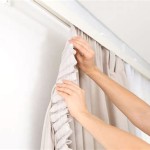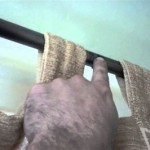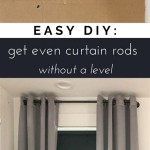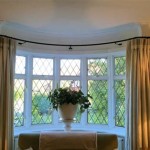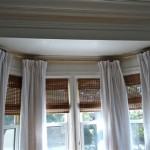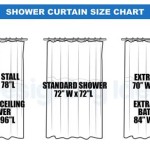How to Attach Curtains Without Drilling
Attaching curtains is often perceived as a task requiring drilling, which can be daunting for renters, individuals hesitant to damage walls, or those seeking a temporary solution. Fortunately, several methods exist to hang curtains securely and stylishly without resorting to drills, screws, or nails. These alternatives offer versatility, ease of installation, and minimal impact on the existing structure of the wall or window frame. This article provides a comprehensive guide to various no-drill curtain hanging techniques, detailing their advantages, disadvantages, installation procedures, and suitability for different window types and curtain weights.
The absence of drilling eliminates the need for tools like power drills, screwdrivers, and spirit levels. It also sidesteps the potential creation of unsightly holes, the inconvenience of patching and repainting, and the possibility of damaging hidden pipes or wiring within the wall. No-drill methods are particularly beneficial in rental properties where modifications are often restricted and tenants are responsible for restoring the premises to their original state upon departure.
Furthermore, these methods offer flexibility. Curtains can be easily repositioned or removed without leaving permanent marks. This is advantageous for individuals who enjoy changing their décor frequently or who need to adjust curtain placement to accommodate changing light conditions or privacy needs. The ease of installation also makes these techniques suitable for DIY enthusiasts and those who may lack experience with power tools.
Using Tension Rods
Tension rods are a widely recognized and readily available solution for hanging curtains without drilling. These rods rely on spring-powered tension to grip the inside of the window frame or the opening of a doorway. Their simplicity and ease of installation make them a popular choice for lightweight curtains and sheer fabrics. However, it is crucial to select a tension rod with sufficient weight-bearing capacity to prevent slippage or collapse, particularly when using heavier curtains.
The installation process for tension rods is straightforward. First, measure the width of the window frame or desired hanging location. Choose a tension rod that slightly exceeds this measurement. Extend the rod by twisting the inner section until it is longer than the measured width. Position the rod inside the frame or opening, ensuring it is level. Slowly release the tension on the rod, allowing the spring mechanism to exert pressure against the frame. Check the rod's stability by gently tugging on it. Adjust the tension as needed until the rod feels secure.
Tension rods are best suited for lightweight curtains in standard-sized windows. They are less effective with heavy drapes or curtains that are frequently drawn, as the constant movement can gradually loosen the rod's grip. Moreover, tension rods may not be suitable for wider windows or doorways, as the increased span can compromise their stability. Consider the aesthetic limitations as well; tension rods are often visible and may not complement all interior design styles.
Variations of tension rods include curved tension rods, designed for shower curtains but adaptable for window treatments, and adjustable tension rods with decorative finials, which offer a more refined appearance. When selecting a tension rod, prioritize quality and weight capacity to ensure a reliable and long-lasting solution.
Adhesive Hooks and Command Strips
Adhesive hooks and Command strips offer another drill-free approach to curtain hanging, relying on strong adhesive to attach to the wall or window frame. These options are versatile and can be used with a variety of curtain types, provided the weight limits are carefully considered. The key to successful installation with adhesive products lies in proper surface preparation and adherence to the manufacturer's instructions.
Before applying adhesive hooks or strips, thoroughly clean the surface with rubbing alcohol to remove any dirt, grease, or residue. Allow the surface to dry completely before proceeding. Position the hooks or strips according to the desired curtain rod placement. Apply firm pressure to ensure the adhesive makes full contact with the surface. Allow the adhesive to cure for the recommended time, typically 24 hours, before hanging the curtain rod or attaching the curtains directly to the hooks.
Adhesive hooks and Command strips are available in various sizes and weight capacities. Select products specifically designed for hanging curtains and choose a weight capacity that exceeds the actual weight of the curtains to provide a safety margin. Distribute the weight evenly by using multiple hooks or strips along the length of the curtain rod. Regularly inspect the adhesive for signs of weakening or detachment and reapply as needed.
This method is particularly useful for lightweight curtains, valances, or sheer panels. While some heavy-duty adhesive hooks and strips are marketed for heavier curtains, it's advisable to exercise caution and test the stability before relying on them for valuable or delicate fabrics. Consider the surface material as well; adhesive may not adhere well to textured walls, wallpaper, or certain types of paint. Removability is another factor; while Command strips are designed to be removed without damaging the surface, some adhesive hooks may leave residue or peel paint upon removal. Always test in an inconspicuous area before applying adhesive to a visible surface.
Innovative adhesive solutions are constantly emerging, including reusable adhesive pads and strips that offer enhanced grip and removability. Explore these options and choose products from reputable brands to ensure a reliable and long-lasting hold.
Using Magnetic Curtain Rods
Magnetic curtain rods provide a unique and convenient solution for hanging curtains on metal surfaces without drilling. These rods utilize strong magnets to adhere directly to steel doors, metal window frames, or other ferromagnetic surfaces. This method is particularly well-suited for temporary installations, metal entry doors, or RV applications where drilling is impractical or undesirable. However, its applicability is limited to environments with suitable metal surfaces.
Before using magnetic curtain rods, ensure the surface is clean and free of any rust, paint chips, or debris that could interfere with the magnetic adhesion. Test the magnetic strength of the surface by attaching a small magnet to assess its holding power. Choose magnetic curtain rods with sufficient strength to support the weight of the curtains. Consider the curtain's weight, length, and material when selecting the appropriate rod.
Installing magnetic curtain rods is simple. Position the rod on the metal surface and allow the magnets to secure it in place. Adjust the rod as needed to ensure it is level and centered. Hang the curtains onto the rod, distributing the weight evenly. Periodically check the magnetic adhesion to ensure the rod remains secure. If necessary, clean the magnets and the metal surface to remove any buildup that could reduce their grip.
Magnetic curtain rods are available in various lengths, styles, and weight capacities. Some models feature adjustable rods to accommodate different window sizes. They are especially useful for hanging lightweight curtains, sheers, or valances on metal doors or windows. However, they are not suitable for heavy drapes or curtains that are frequently drawn, as the constant movement can weaken the magnetic bond.
The effectiveness of magnetic curtain rods depends on the quality of the magnets and the thickness and composition of the metal surface. Weak magnets or thin metal can compromise the rod's stability. Moreover, magnetic rods are limited to ferromagnetic surfaces only and cannot be used on aluminum, wood, or other non-magnetic materials. Consider the aesthetic limitations as well; magnetic rods are often visible and may not complement all interior design styles. When selecting a magnetic curtain rod, prioritize quality and weight capacity to ensure a reliable and long-lasting solution for suitable metal surfaces.
In summary, attaching curtains without drilling offers a range of practical and versatile solutions for various window types and curtain weights. Tension rods, adhesive hooks, and magnetic curtain rods each provide unique advantages and limitations. By carefully considering the specific requirements of the installation, selecting appropriate materials, and following the manufacturer's instructions, it is possible to achieve a secure and stylish curtain hanging solution without resorting to traditional drilling methods. The ultimate choice depends on factors such as the weight of the curtains, the type of window frame or wall material, and the desired aesthetic outcome.

5 Easy Ways To Hang Curtains Without Drilling

How To Hang Curtains Without Drilling 2 Solutions

How To Hang Curtains Without Drilling 2 Solutions

How To Hang Curtains Without Drilling

How To Hang A Curtain Rod Without Drilling Into The Wall

Easy And Creative Ways To Hang Curtains Without Drilling Holes Pardewale In

5 Easy Ways To Hang Curtains Without Drilling

5 Easy Ways To Hang Curtains Without Drilling

5 Easy Ways To Hang Curtains Without Drilling

Ingenious Ways To Hang Curtains Without Drilling Holes


